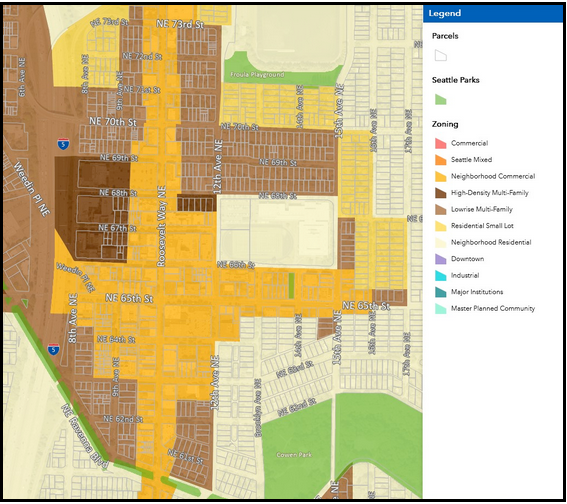Many Roosevelt residents have questions about what gets built in our neighborhood and why. The term land use refers to conversations and decisions about the role that a given piece of land should play. Whether the result is a park, a shopping center, or an apartment building, land use outcomes are determined by a combination of regulations set by the government, choices made by property owners, and opinions voiced by the public. The Roosevelt Neighborhood Association (RNA) provides a platform for Roosevelt residents and business owners to pursue the land use solutions that will serve our neighborhood best.
Land Use FAQs:
How is Roosevelt currently zoned?
Local government’s primary tool for shaping land use is called zoning. Throughout the United States, cities use zoning to establish a piece of land’s socioeconomic purpose – residential, commercial, industrial, and recreational are a few familiar examples. Far more than just broad categories, zoning classifications determine specific requirements like how many units can be built in a residential dwelling, how many stories an office tower can reach, and how much parking a commercial development must feature.
In Seattle, zoning is governed by the Seattle Municipal Code. Changes to the code are voted on by the Seattle City Council, based on recommendations from the Office of Planning and Community Development. More information on zoning, including links to searchable maps, can be found at the city’s zoning webpage.
The map below, found on the City of Seattle’s online GIS portal, illustrates the current zoning for central Roosevelt. Using the legend, do you recognize how familiar locations in Roosevelt line up with their zoning designations?
What is a Residential Urban Village?
Seattle’s 2005 Comprehensive Plan designated Roosevelt as a Residential Urban Village. This category applies to walkable, mixed-use neighborhoods that are primarily residential in character but also feature 3-8 story buildings, retail, and transit access. Sound familiar? Other Residential Urban Villages that you might recognize from around Seattle include Wallingford, Phinney Ridge, and Columbia City. Residential Urban Villages are zoned to encourage moderate increases in density.
While most of Roosevelt still consists of single-family homes (some 500 units as of April 2025), long-term residents will affirm that the neighborhood has grown tremendously in the past 20 years. As a transportation hub featuring a light rail station, multiple arterial roads, and an interstate freeway entrance, the neighborhood is positioned for another growth cycle in the years ahead. Seattle’s upcoming One Seattle Plan will reclassify Roosevelt (and other existing residential urban villages) to a new category known as “Urban Center.” Since this plan is still undergoing review, the RNA will provide updates on its projected impact in our newsletter as they become available.
What can we do about abandoned commercial or residential properties?
Abandoned buildings present neighborhoods like ours with serious challenges. In addition to creating direct safety concerns like structural collapse and fire hazards, abandoned buildings can have undesirable effects on crime, public health, and property values. In Seattle, the Department of Construction and Inspections (SDCI) is responsible for making decisions about abandoned buildings and their potential demolition. When property owners prove unresponsive, the SDCI can place a lien on a property to recover its demolition costs.
You can report an abandoned building by phone (206-615-0808), email (sci_complaintsinfo@seattle.gov), the SDCI website or the “Find It, Fix It” app.
Why so many empty lots?
“Why are there so many empty lots in Roosevelt?” is one of the most common questions we hear from our neighbors. We wish we had a better answer, but we do have ideas!
Regardless of zoning, every unoccupied piece of land has an owner. In most cases, only those owners can decide when to develop or resell their property. Real estate development is a lengthy, expensive and complicated process requiring economic conditions to align with property owners’ goals and resources. There is unfortunately little that neighborhood residents can do to directly expedite that process.
What the RNA can do is make Roosevelt a more attractive neighborhood to build in. The way we see it, the most effective way to minimize empty properties is to increase the demand for the homes and businesses that will eventually fill those spaces. We can accomplish this by:
- Making our neighborhood safe, clean and welcoming
- Creating a thriving community that supports residents, businesses and visitors
- Strengthening ties with our local government in order to maximize Roosevelt’s potential
You Can Make a Difference.
We talk about land use issues for Roosevelt at many of our monthly meetings. Check out “What to Expect at an RNA Meeting” if you’re interested in joining us.
